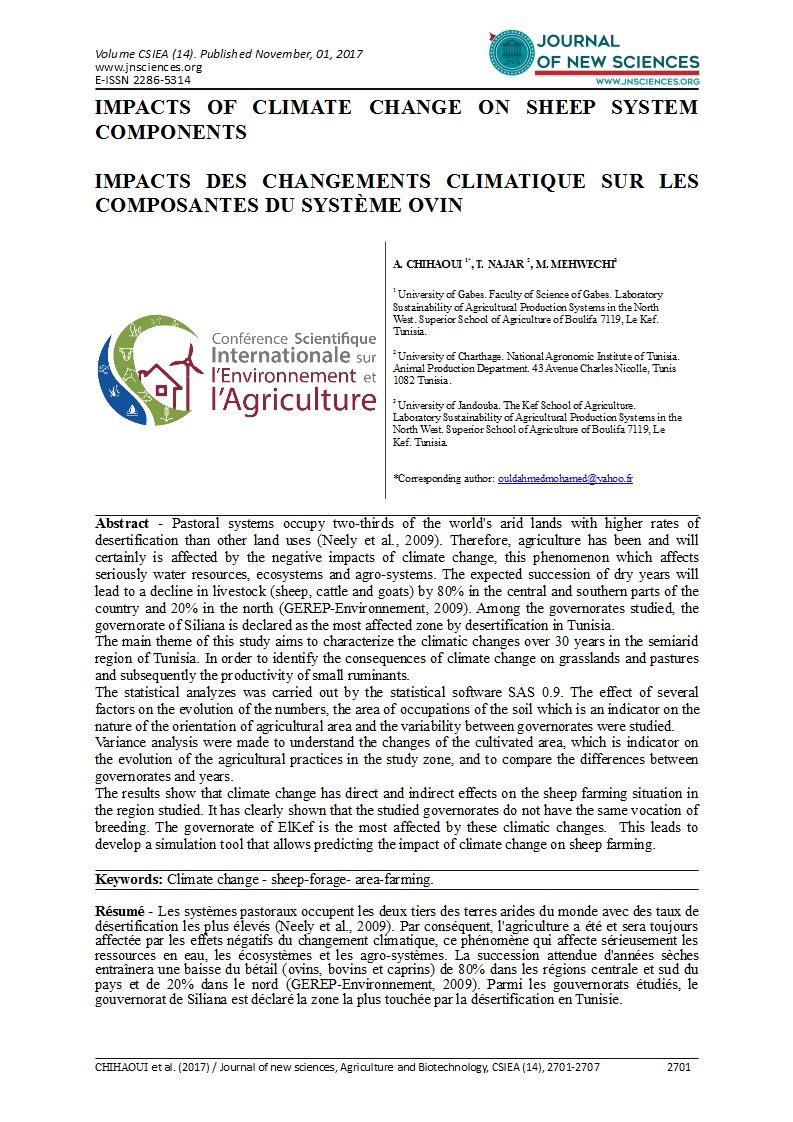

- Category: Volume spécial (Conférence CSIEA 2017)
- Hits: 18479
IMPACTS OF CLIMATE CHANGE ON SHEEP SYSTEM COMPONENTS
IMPACTS DES CHANGEMENTS CLIMATIQUE SUR LES COMPOSANTES DU SYSTÈME OVIN
|
|
A. CHIHAOUI 1*, T. NAJAR 2, M. MEHWECHI3
1 University of Gabes. Faculty of Science of Gabes. Laboratory Sustainability of Agricultural Production Systems in the North West. Superior School of Agriculture of Boulifa 7119, Le Kef. Tunisia. 2 University of Charthage. National Agronomic Institute of Tunisia. Animal Production Department. 43 Avenue Charles Nicolle, Tunis 1082 Tunisia. 3 University of Jandouba. The Kef School of Agriculture. Laboratory Sustainability of Agricultural Production Systems in the North West. Superior School of Agriculture of Boulifa 7119, Le Kef. Tunisia.
|
Abstract - Pastoral systems occupy two-thirds of the world's arid lands with higher rates of desertification than other land uses (Neely et al., 2009). Therefore, agriculture has been and will certainly is affected by the negative impacts of climate change, this phenomenon which affects seriously water resources, ecosystems and agro-systems. The expected succession of dry years will lead to a decline in livestock (sheep, cattle and goats) by 80% in the central and southern parts of the country and 20% in the north (GEREP-Environnement, 2009). Among the governorates studied, the governorate of Siliana is declared as the most affected zone by desertification in Tunisia.The main theme of this study aims to characterize the climatic changes over 30 years in the semiarid region of Tunisia. In order to identify the consequences of climate change on grasslands and pastures and subsequently the productivity of small ruminants.The statistical analyzes was carried out by the statistical software SAS 0.9. The effect of several factors on the evolution of the numbers, the area of occupations of the soil which is an indicator on the nature of the orientation of agricultural area and the variability between governorates were studied. Variance analysis were made to understand the changes of the cultivated area, which is indicator on the evolution of the agricultural practices in the study zone, and to compare the differences between governorates and years. The results show that climate change has direct and indirect effects on the sheep farming situation in the region studied. It has clearly shown that the studied governorates do not have the same vocation of breeding. The governorate of ElKef is the most affected by these climatic changes. This leads to develop a simulation tool that allows predicting the impact of climate change on sheep farming.
Keywords: Climate change, sheep, forage, area, farming.
Résumé - Les systèmes pastoraux occupent les deux tiers des terres arides du monde avec des taux de désertification les plus élevés (Neely et al., 2009). Par conséquent, l'agriculture a été et sera toujours affectée par les effets négatifs du changement climatique, ce phénomène qui affecte sérieusement les ressources en eau, les écosystèmes et les agro-systèmes. La succession attendue d'années sèches entraînera une baisse du bétail (ovins, bovins et caprins) de 80% dans les régions centrale et sud du pays et de 20% dans le nord (GEREP-Environnement, 2009). Parmi les gouvernorats étudiés, le gouvernorat de Siliana est déclaré la zone la plus touchée par la désertification en Tunisie. Le thème principal de cette étude vise à caractériser les changements climatiques de plus de 30 ans dans la région semi-aride de Tunisie. Afin d'identifier les conséquences du changement climatique sur les prairies et les pâturages et par la suite, la productivité des petits ruminants. Les paramètres étudiés ont été analysés statistiquement par une analyse de la variance avec le logiciel statistique SAS 0.9. L’effet de plusieurs facteurs sur l’évolution des effectifs et la superficie des occupations du sol est un indicateur sur la nature de l’orientation agricole dans la région d’étude et la mesure de la variabilité entre les gouvernorats ainsi que la variabilité interannuelle. Les résultats de l’étude de ces quatre paramètres climatiques, montrent que les changements climatiques ont des effets directs et indirects sur la situation d’élevage ovin dans la région étudiée. Ils ont mis en évidence que les gouvernorats concernés ne possèdent pas la même vocation d’élevage sachant que le gouvernorat le plus affecté par ces changements est celui du KEF. Ce qui nous conduit à l’intérêt de mettre en place un outil de simulation qui nous permettrait de prévoir l’impact des changements climatique sur l’élevage ovin.
Mots clés : Changements climatiques – ovins-superficies fourragères-parcours-élevage

